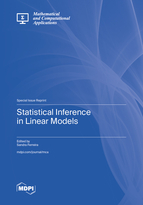Statistical Inference in Linear Models
A special issue of Mathematical and Computational Applications (ISSN 2297-8747).
Deadline for manuscript submissions: closed (15 January 2023) | Viewed by 17834
Special Issue Editor
Interests: applied statistics; computational mathematical methods; distribution theory; linear models; prediction; statistical inference
Special Issues, Collections and Topics in MDPI journals
Special Issue Information
Dear Colleagues,
Linear models are very important statistical models with a role in several fields of science, and are of practical importance in statistics. The most typical is the linear regression model. Many phenomena, such as those in biology, medicine, economics, management, geology, meteorology, agriculture and industry, can be approximately described by linear models. The further research and development of linear models is still a very active research subject.
In this Special Issue, we invite front-line researchers and authors to submit novel and original research. Potential topics include, but are not limited to:
- Prediction and testing in linear models;
- Regression and linear models;
- Econometrics;
- Robustness of relevant statistical methods;
- Modelling and simulation;
- Estimation of variance components;
- Parameter estimation in linear models
- Sampling techniques;
- Applications of linear models;
- Design and analysis of experiments;
- Statistical applications;
- Generalized linear models.
The collection of papers will be complete in the sense that it will reflect the state of the art in the area and contain all recent important developments, keeping in mind that the Issue is for the benefit of both young researchers coming into the field as well as seasoned researchers.
For further information, please send an email to: sandraf@ubi.pt.
Dr. Sandra Ferreira
Guest Editor
Manuscript Submission Information
Manuscripts should be submitted online at www.mdpi.com by registering and logging in to this website. Once you are registered, click here to go to the submission form. Manuscripts can be submitted until the deadline. All submissions that pass pre-check are peer-reviewed. Accepted papers will be published continuously in the journal (as soon as accepted) and will be listed together on the special issue website. Research articles, review articles as well as short communications are invited. For planned papers, a title and short abstract (about 100 words) can be sent to the Editorial Office for announcement on this website.
Submitted manuscripts should not have been published previously, nor be under consideration for publication elsewhere (except conference proceedings papers). All manuscripts are thoroughly refereed through a single-blind peer-review process. A guide for authors and other relevant information for submission of manuscripts is available on the Instructions for Authors page. Mathematical and Computational Applications is an international peer-reviewed open access semimonthly journal published by MDPI.
Please visit the Instructions for Authors page before submitting a manuscript. The Article Processing Charge (APC) for publication in this open access journal is 1400 CHF (Swiss Francs). Submitted papers should be well formatted and use good English. Authors may use MDPI's English editing service prior to publication or during author revisions.






